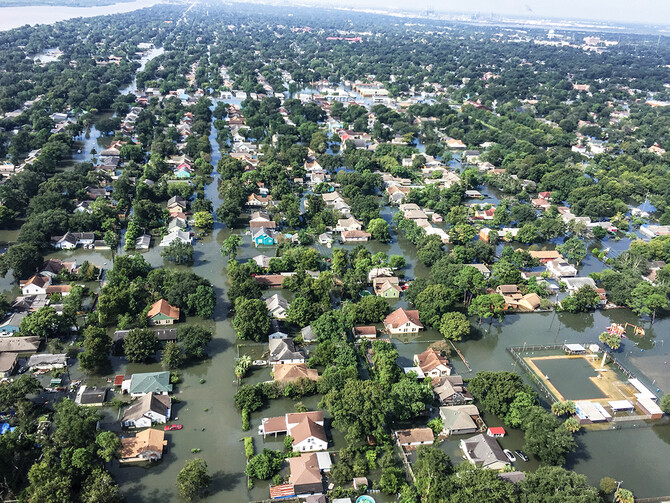Why don’t we better prepare for disasters?
When Hurricane Harvey was bearing down on the Texas coast, few people were caught off guard. Weather models predicted when and roughly where the storm would make landfall and officials, including Houston Mayor Sylvester Turner, asked people ahead of the storm to “hunker down” and prepare.
Experts, too, knew Harvey was coming. And they knew the results would likely be bad.
For years, experts had warned about a catastrophic flooding event in Houston. Harvey has been called a “500-year-flood,” which means there’s a 1-in-500 chance of something like it happening every year. The catch is, officials have measured several of these 500-year-floods in the past decade in Houston, and eight nationwide between August 2015 and August 2016, according to the National Weather Service.
Hurricane Irma, which made landfall in the Caribbean before hitting the Florida Keys and Marco Island, is tied as the second-most intense Atlantic hurricane.
These events are happening with more frequency and with dire consequences. The death toll from Harvey has risen to more than 80, and estimates put the financial damages from both storms at more than $200 billion.
If we know these events will be bad—and will only worsen with the compounded effects from climate change—why don’t we better prepare for them?
It mostly comes down to a set of systemic biases, says Howard Kunreuther, a risk management expert at Wharton, which leads us to underinvest in protection against low-probability, high-consequence events.
“We tend to think about what’s going to happen in the short run rather than in the long run,” he explains.
Take the example of someone with a flooded house. If they’re told to elevate their home to lessen the impact from flooding, they’ll likely ask how much it will cost up front. They may focus on a return on investment in the next two or three years, when Kunreuther says they should be thinking about it as a measure that will last the life of the house, which is likely to be decades.
This is an example of myopia—one of the six core biases Kunreuther says hinder our ability to deal with rare threats about which we know little. In the book, “The Ostrich Paradox: Why We Underprepare for Disasters,” co-authored with Wharton colleague Robert Meyer, the authors outline biases and offer strategies that work with, not against, these natural tendencies.
These include forgetting the lessons of past disasters, underestimating the likelihood of future losses, maintaining the status quo, addressing some but not all of the factors when making choices about risk, and basing choices on what others are doing.
Kunreuther explains that people dislike thinking about negative events, prefer to put off major decisions, and opt to purchase insurance after the fact, rather than before. The number of people who purchased flood insurance policies rose after Hurricane Katrina, for example, but dropped three years later, when residents had not suffered losses and felt premiums were wasted.
Kunreuther and Meyer outline what they call a behavioral risk audit and propose several ways in which people can address risk in the context of core biases.
They say that the best way to address the myopia bias is to reduce the pain of paying for expensive preventative measures up front with long-term loans to spread the cost over time. By providing information on the likelihood of an event by stretching the time horizon, those at risk are more likely to pay attention to the potential consequences of a disaster. If people hear there’s a 1 in 100 chance something could happen, they’ll tune out.
“If we tell a person, there’s a greater than 1 in 5 chance that there may be at least one loss in the next 25 years, people are going to pay attention to that. These two probabilities are identical if the chance of a disaster is identical from year to year,” Kunreuther says.
A remedy to inertia is multiyear all-hazard homeowners insurance that locks in benefits for a number of years, where the policy covers earthquake and flood damage in addition to wind damage, part of a standard policy.
He says there are two complementary ways one can prepare for disasters.
“You want to make sure that messages are framed in ways that people pay attention,” he says. “We have a general philosophy in the [Wharton Risk Management and Decision Processes Center] that you absolutely have to have short-term incentives and must be tied in with long-term strategy.” Incentives could be loans that spread the up-front cost of flood insurance over time.
Changes must have enough immediate benefits that politicians also see the wisdom of investing in a long-term strategy.
The second is recognizing that we have these biases. “They’re part of our cognitive wiring,” Kunreuther says.
While it’s too early to say if lessons learned during hurricanes Sandy and Katrina were implemented during Harvey and Irma, Kunreuther says this moment presents an opening.
“Flood insurance that is marketed by the federal government through the National Flood Insurance Program is up for renewal this year,” Kunreuther says. “Harvey and Irma offer a great opportunity to pass a decent flood insurance bill that recognizes the importance of better mapping, the need for encouraging investments in loss reduction measures, while at the same time addressing issues of affordability and fairness.”
Howard Kunreuther is the James G. Dinan Professor; co-director of the Risk Management and Decision Processes Center; professor of decision sciences and business economics and public policy; and professor of operations, information, and decisions at the Wharton School.
Robert Meyer is the Frederick H. Ecker/MetLife Insurance Professor; professor of marketing; and co-director of the Risk Management, Decision Processes Center at the Wharton School.








